
Carl Zeiss
Jena Werra 3: East German Excellence
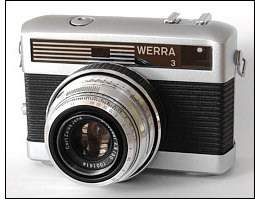 Classic camera author and columnist Ivor Mantanle has described this as
being one of the only cameras to bear the Carl Zeiss name. The Werra came
from the East German Carl Zeiss Jena operation, and regardless of how you
might think of Carl Zeiss Jena, there is no denying that the Werra is one
fine camera and is worthy of the Carl Zeiss name. Classic camera author and columnist Ivor Mantanle has described this as
being one of the only cameras to bear the Carl Zeiss name. The Werra came
from the East German Carl Zeiss Jena operation, and regardless of how you
might think of Carl Zeiss Jena, there is no denying that the Werra is one
fine camera and is worthy of the Carl Zeiss name.
The Werra is unique in its design and operation, and you can honestly say
that there are few cameras like it. I'll focus on the Werra 3, because
that happens to be the camera that I own. There were a large number of
Werra models. Some were zone focus, while others had rangefinders. Some
had meters; some didn't. Some had meters and rangefinders, and some had
neither. On some early cameras, the standard lens was a Novonar (East German
equivalent of a Novar), while other Werras had a Tessar. Some also had a
green leather covering. This camera has black ribbed fabric -- somewhat
like the Iaghee Exa, but not exactly like it. To be sure, there were
plenty of models to suit almost any photographer.
The Werra also had built-in diopter correction. What a novel feature
for that time. It's simple yet effective, just like many things regarding
this little camera.
The first thing that you notice about the Werra is the apparent lack of controls on the camera. No film advance, no dials, switches or knobs. Just
a shutter release on the top and the lens. The beauty of the Werra is in
its simplicity and how it accomplishes its tasks with little effort.
I bought this camera from a fellow classic camera enthusiast, and I've been
very pleased with it.
Werra my camera settings?
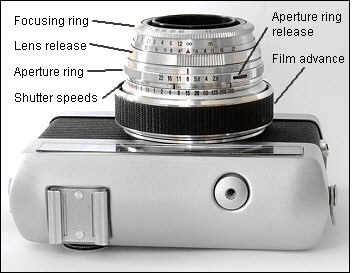 The
location and purpose of the controls on the lens are marked in this photo. The
location and purpose of the controls on the lens are marked in this photo.
The film advance is the large ring that sits at the base of the lens,
nearly touching the front of the camera. A quick 90-degree clockwise twist
advances the film and tensions the shutter.
The aperture ring and shutter speed dial are locked, as if in a light
value system (LVS). However, there are no LVS numbers on the dial, and the
reason they are locked is to allow you to change shutter speeds. There is
no knurling or serrated edge on the shutter speed dial. So what you do is
first select your desired shutter speed and then press the aperture ring
release and turn the dial to the desired aperture. And once you have the
right combo, you can leave the two rings locked and select different a
different shutter speed or aperture and still have correct exposure. It's
a bit like an LVS sytem, except there are no LVS markings.
There is a depth of field scale marked just above the lens release;
this is part of the lens. Turn the lens release counterclockwise about 10
degrees, and the lens can be removed from the body. More on that later.
Distances are marked in meters on the lens barrel and in feet on the lens
bezel.
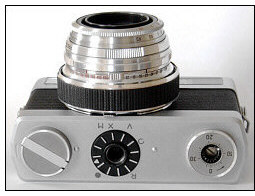 The only other controls on the top deck are an accessory shoe (not all
Werra models have this), and the shutter release. The top deck on this
model is rounded. Other models had a flat top deck, although the general
shape with the crescent-shaped sides remained with the cameras. The only other controls on the top deck are an accessory shoe (not all
Werra models have this), and the shutter release. The top deck on this
model is rounded. Other models had a flat top deck, although the general
shape with the crescent-shaped sides remained with the cameras.
The
bottom is also spartan:
A frame counter, markings for flash
synchronization and self-timer, knob/dial for opening the camera and
rewinding the film and rewind crank. Some cameras had a plain rewind knob,
and a crank is always a welcome feature.
By the way, M is bulb flash, X is electronic flash and V is self-timer.
These markings are pretty much universal for all German cameras: East or
West.
The curious thing about the dial for the back release is this. The gray dot
indicates closed. Turn the arrow to "R" for rewind. But C is open. I guess
the C stands for a German word (sorry, I don't know any German).
Removing the back shows a very clean interior. Film feeds from right to
left. There is a takeup spool, sprocket wheel, film gate, the chamber for
the film canister and that's it.
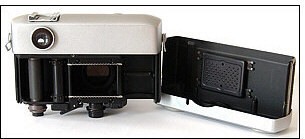 The
back has a tiny pressure plate. I wasn't sure if this was large enough for
the job, but it is. The
back has a tiny pressure plate. I wasn't sure if this was large enough for
the job, but it is.
Loading the film was slightly tricky the first time around, because you
must force the film between the metal flange and the inner spool. Pressure
holds the film leader. It took me a couple of tries to get it the first
time, and I suspect that like most things, practice makes perfect. Fire
off two blanks, use your thumb to reset the film counter to "0," and you're good to go.
The one thing I added was some white in the film counter notch. There
was no color, and it was extremely difficult to see the small indentation
to figure out how many shots I had taken.
Adjustments
Before I could use the camera, I had to adjust the rangefinder. That's
fairly common with most rangefinders, so no big deal. If you look at the
camera again, you'll notice that not only are there no apparent camera
controls, there are also no apparent screws to remove to disassemble the
camera.
So the question became: How do I remove the top deck? The answer:
Remove the studs that hold the strap lugs on either end of the camera.
There are no screwdriver slots, so I ended up wrapping the jaws of some
needle-nose pliers with black fabric tape and carefully gripping and loosening the
studs. It's very difficult to not damage the edges of the studs, and I
suspect there was a special tool to accomplish this.
After both studs are removed (make sure not to lose the nylon spacers),
partially lift the top deck and unscrew and remove the eyepiece. The top
deck will now lift off. You can't remove the eyepiece unless the top deck
is partially lifted -- about 1mm. It's a good safeguard against accidentally
unscrewing the eyepiece in normal use.
The next oddity is the rangefinder. The Werra doesn't use a coincidence
rangefinder system. There is no secondary image. The rangefinder patch
replaces the central part of the viewfinder, and focusing is accomplished
by aligning the rangefinder patch with the rest of the image.
Therefore, precise horizontal and vertical alignment is an absolute
necessity. Luckily, it's very simple to make horizontal and vertical
adjustments to the rangefinder. By the way, I found that if you remove the
shutter from the body, you need to remove the top deck in order to get the
linkage back in place for the rangefinder when reattaching the lens.
UPDATE: A very
alert reader and Werra fan tipped me off to this method for adjusting the
rangefinder. Remove the back and just under the top deck is a screw. Removal of
the screw will give you access to the set screw (set deeper inside the top deck)
that will allow you to make horizontal adjustments to the rangefinder. This work
is best done with the camera mounted to a tripod.
The shutter was fine. Slow speeds buzz nicely, as does the self-timer.
This is one of the later models, because the Prestor shutter tops out at
1/750. That's quite a feat for a leaf shutter, although I know that some
Copals hit 1/1000. Regardless, the Prestor shutter is excellent. It's a
bit different from other leaf shutters in that it uses a double-blind
system. Most leaf shutters are self-capping. That is, they don't open when
you tension them. The Prestor has another level of protection. The blind
slides out of the way when the shutter is tensioned and back into place
after the shutter is closed.
How it handled
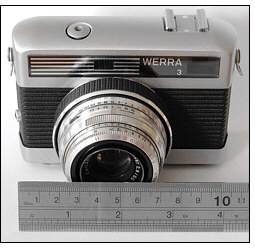 To
get right to the point: I really like this camera. It's small, but not too
small. Focusing the camera requires a bit of rethinking, because of the
number of serrated-edge dials on the camera. Luckily, the lens release
dial requires a stiff turn. Otherwise, you'd "focus" the longer lens right
off the camera. To
get right to the point: I really like this camera. It's small, but not too
small. Focusing the camera requires a bit of rethinking, because of the
number of serrated-edge dials on the camera. Luckily, the lens release
dial requires a stiff turn. Otherwise, you'd "focus" the longer lens right
off the camera.
The film advance/shutter tensioning ring works brilliantly. And once I
understood that you first set the shutter speed and then the aperture,
things went very smoothly.
The Werra has true lens interchangeability. The shutter sits behind the
lens. There are no lens elements in the body. So each lens is its own
unit, and all are unit-lens focusing rather than front-cell. In theory,
the unit-focusing design is sharper, although I've had quite good
experience with front-cell Tessars and Novars.
The standard lens is a coated f/2.8 50mm Tessar. The other common
lenses are a 35mm Flektogon and a 100mm Cardinar, which came with my
camera. The viewfinder has three sets of framelines -- one for each of the
lenses. The framelines also contain parallax marks, which helps because the
framelines are static -- they don't move as you focus the lens.
I found the Tessar and Cardinar to be quite capable with plenty of
sharpness and contrast. I'm reasonably certain the Flektogon also falls
into this category. After all, these are Carl Zeiss Jena lenses. I
detected some vignetting when shooting the Cardinar wide open. This might
be an attractive feature in some situations, and a drawback in others.
The only negative is the use of aluminum in the mounts. The Cardinar
could use a cleaning and relubrication of the helicals. It's a bit tighter
than it needs to be. The Tessar rotates very smoothly within its helical.
Build quality of both lenses is very high.
I have no problem recommending a Werra, but make sure the shutter runs
correctly at all speeds and that the rangefinder (if the desired camera
has one) is accurate.
See some photos » |